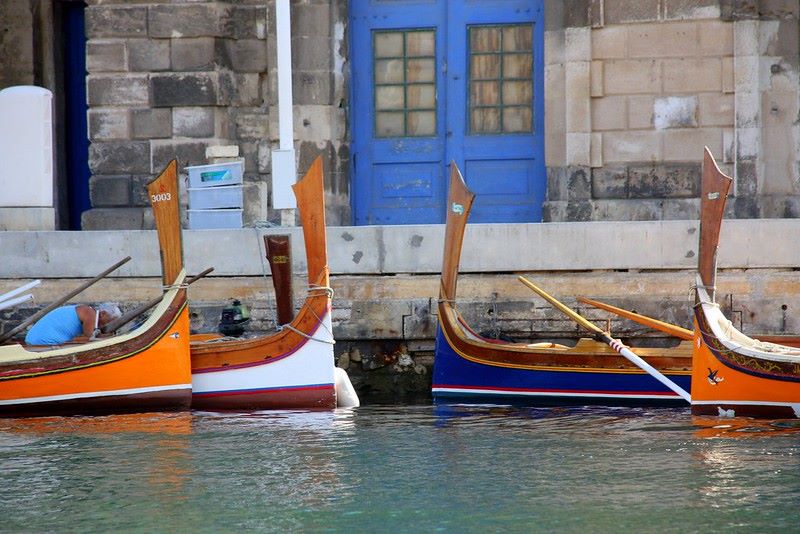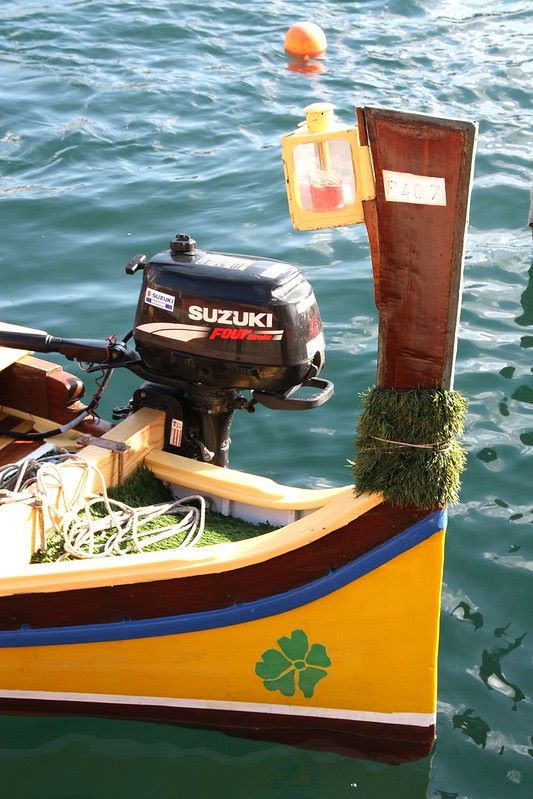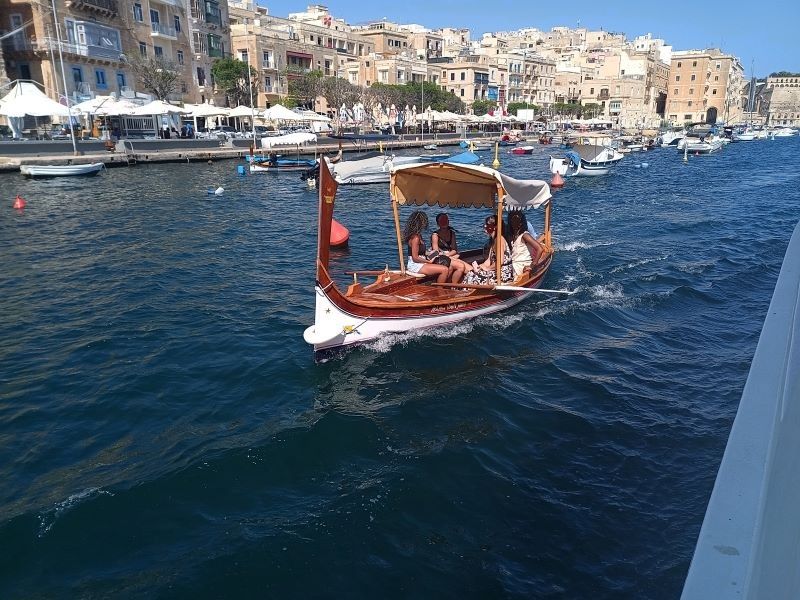| Malta Short Let: Cozy Stay in Gzira | |
|
Sliema Area Modern Designer Finished 2 Bedrooms + Games Room. First floor with Maltese Balcony Large back Terrace with swinging sofa Fully Airconditioned + Full Kitchen 3 TVs, including 65” with backlight. |
 |
|
Book Now: Google Travel | Direct (Cheapest) | Booking.com | Airbnb |
|
Imagine the calm waters of Malta’s Grand Harbour, with the sun casting a golden light over Valletta’s fortifications. Cutting through the water, a small, traditional wooden boat glides by—this is the dgħajjes tal-pass, a symbol of Malta’s maritime heritage and a piece of living history. These boats, known for ferrying people between the fortified cities of Valletta and the Three Cities—Birgu, Senglea, and Cospicua—once dominated the harbor’s daily life. Today, however, their numbers have dwindled, leaving just a handful in the Cottonera area, particularly around Isla and Birgu, where they now survive primarily as tourist attractions. The three cities have a rich history.

A Legacy that Nearly Faded Away
Centuries ago, the dgħajjes tal-pass were the heartbeat of Malta’s busy harbor. With no bridges, they were the fastest and most reliable way for workers, merchants, and sailors to cross the harbor. Each morning, the boatmen—known as the barcari—rowed passengers across the harbor’s blue-green waters. These small water taxis were as essential to daily life as buses or trains might be today.
As Malta modernized, roads and bridges began to replace the need for these water taxis. The decline accelerated, and the dgħajjes began to vanish, nearly becoming relics. Today, you’ll only find a few still operating, and they’re mostly used by visitors who want to experience the Grand Harbour from the water, looking out over Malta’s historic skyline as countless seafarers have done before. Yet, for the few that remain, keeping these boats on the water isn’t easy.
Keeping the Tradition Alive: The Barklori Cooperative
The Barklori Cooperative—a group dedicated to the preservation of these boats—is actively working to ensure that the dgħajjes tal-pass don’t completely disappear. They’re appealing to Maltese authorities for support, recognizing that preserving these boats goes beyond nostalgia; it’s about keeping an integral part of Malta’s history alive. Each dgħajjes requires constant care and maintenance to stay seaworthy, as many are over 150 years old. While the original craftsmanship is revered, wear and tear mean that some parts have to be replaced. Boatmen today, many of whom inherited their dgħajjes from their fathers or grandfathers, pour countless hours into maintaining these vessels, a process that feels almost like caring for a living heirloom.

One such boat, handed down from a local boatman’s grandfather, will soon join a small fleet commemorating the 100th anniversary of Manwel Dimech’s exile—a tribute to both Malta’s history and the resilience of its people and traditions. As the event approaches, the Barklori Cooperative’s mission is renewed, and it’s clear that their fight is not just for a means of transport but for a piece of the island’s soul.
A Reminder Amidst the Modern World
In Isla, where these boats once bobbed freely among merchant vessels, the modern landscape has changed significantly. Luxurious yachts and modern sailboats have taken over, dwarfing the dgħajjes tal-pass in size and presence. Yet, there’s something almost magical about spotting one of these traditional boats among the modern fleet—a rare reminder of the island’s past. Their sleek, curved shape and bright, hand-painted colors stand out, a hint of Malta’s character against a backdrop of contemporary opulence.
Tourists who spot a dgħajjes may stop and stare, drawn to the simplicity and charm of a small boat that’s been crossing these waters for generations. For many visitors, taking a short trip across the harbor in one of these boats is a chance to experience Malta’s maritime culture up close, feeling the rhythm of the oars in the water and catching the salty breeze.

Craftsmanship and Connection
The dgħajjes tal-pass are crafted with meticulous care. Each boat is narrow, designed to slice cleanly through the water, with its bow and stern curving upward—a nod to ancient boat designs dating back to the Phoenicians. These boats are no mass-produced vessels; they’re handmade, with each detail carefully considered. Bright reds, blues, greens, and yellows decorate their hulls, adding a distinctive Maltese touch. For the boat builders and barcari, each dgħajjes represents a story, a connection to their family’s past, and a piece of cultural heritage.
Maintaining a dgħajjes is a labor of love. It’s not just about keeping the boat afloat but about preserving the soul of a tradition. The care that goes into each boat is evident. Repairs are painstaking, and each coat of paint is applied with pride. With every row, the boatmen continue a legacy that has been passed down through generations.
The Tourist Attraction that Almost Wasn’t
Although the dgħajjes tal-pass are now popular with tourists, it wasn’t always clear that they would survive long enough to become an attraction. Years of decline, rising maintenance costs, and the changing needs of the harbor’s residents nearly spelled the end for these boats. But thanks to groups like the Barklori Cooperative, they continue to offer a unique experience, one that transports visitors beyond the present, letting them see Malta as it once was.
For visitors, stepping into a dgħajjes isn’t just a ride; it’s a chance to connect with Malta’s past. They feel the weight of history with each stroke of the oar, watching Valletta’s ancient fortifications from the same vantage point as generations of boatmen and passengers before them. It’s a quiet, meditative experience, allowing a rare glimpse into the island’s soul.
Suggest itinerary for the three cities.

What the Future Holds
The future of the dgħajjes tal-pass remains uncertain. Without additional support, the Barklori Cooperative’s work to preserve these boats may not be enough. While there’s a strong desire to keep this tradition alive, resources are limited. Yet, for now, these boats continue to grace the waters of the Grand Harbour, a testament to Malta’s resilience and dedication to preserving its heritage.
For the Maltese, losing the dgħajjes would mean losing a piece of themselves, a tangible link to a past that shaped the island’s identity. And so, the boatmen row on, upholding their craft, sharing their stories with tourists, and keeping alive a piece of Malta’s living history.
Take the Journey
If you find yourself in Malta, don’t pass up the chance to ride in a dgħajjes tal-pass. It’s more than just a boat ride—it’s a trip into the heart of Malta’s heritage. As you glide across the harbor, the gentle splash of the oars, the rich colors of the boat, and the stories shared by the boatmen all come together, leaving you with a memory that lingers long after you step ashore. The dgħajjes tal-pass may be small, but they carry with them the weight of Malta’s history, the pride of generations, and a beauty that stands the test of time.
As you cross the harbor, pause to reflect on the battles that shaped this majestic view—from the siege of the Ottomans and the invasion of the French and their blockade to the fierce battles with the Italian and German forces.
Once you cross to the three cities you will have our detailed guide to the three cities to help you find what you want.








